After the theft of a billion dollars from Moldova's coffers — spurring an economic and political crisis — the oldest idea in Moldovan politics has arisen once more. Reunification with neighbouring Romania, from which Moldova was separated in 1940, is seen by some Moldovans as an alternative to their “failed generation” of politicians.
Moldova’s path to Brussels, so it was said, passed through Bucharest
Moldovans have generally been unlucky with governments since independence. Despite plenty of second chances, their neighbours to the west are beginning to lose patience, too.
Seven steps
On 26 January, the new prime minister of Moldova Pavel Filip made his first official visit abroad. The destination was hardly surprising: Romania.
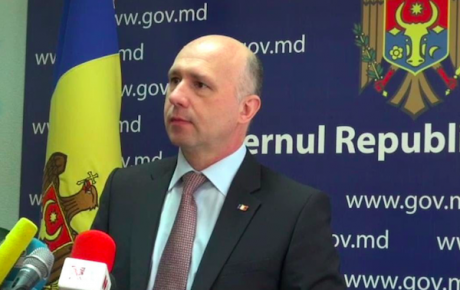
Last September, former prime minister of Romania, Victor Ponta, promised a $150m loan to Moldova in a treaty ratified by the parliaments of both countries. After the fall of the Moldovan government lead by Valeriu Streleț in October 2015, the president of Romania Klaus Iohannis refused to sign off on the loan, stating that “there is no certainty that Moldova will continue its reforms.” Moldova's new prime minister Pavel Filip has returned empty-handed from his first visit to Bucharest, the Romanian capital. Image still via YouTube.So, Filip travelled to Bucharest to bring the first $60m installment of the original loan home. But the new prime minister returned with nothing but a vague statement. As the new Romanian prime minister Dacian Cioloș put it: “before we send any money, we expect from the Moldovan government to take some concrete measures that will prove that there is a political will for reforms.”
A week later, Cioloș sent a list containing seven steps to be taken by the Moldovan government, including the transparent selection of a new governor of the central bank, business-friendly legislation, a new plan to reform the justice sector and a new treaty with the IMF, or at least beginning the negotiations.
After the theft of a billion dollars from Moldova's coffers — spurring an economic and political crisis — the oldest idea in Moldovan politics has arisen once more
This episode is a first in relations between Moldova and Romania. In previous years, discussions had concentrated on lobbying Moldova’s European integration without setting a reformist agenda. “I want to assure you that Romania will stand next to you in this process of European integration,” stated Klaus Iohannis almost a year ago, during his first post-election visit to Moldova. Moldova’s path to Brussels, so it was said, passed through Bucharest.
History lessons
Moldova and Romania were first united in the 17th century, under prince Michael the Brave of Wallachia. In 1859, the principalities of Moldova and Wallachia formed a union, under the name “Romania”. In 1918, this state expanded to include Bukovina, Transylvania, and territories between the Prut and Dniester rivers which had belonged to the Russian Empire. In Moldovan-Romanian relations today, “reunification” will always be the elephant in the room.

In 1940, Romania accepted an ultimatum from Moscow, ceding the territory between the Prut and Dniester (Bessarabia) and the northern part of Bukovina to the Soviet Union. Some of these new territorial gains were organised into the Moldavian Soviet Socialist Republic, and forming Moldova’s current borders. Though Romania made a brief return in 1941, the Red Army reoccupied these territories in 1944. A protest for reunification in Chişinău, 2002. The banner reads: “Romanian language — Romanian people”. Photo CC: Fischka / wikimedia commons.For the next 45 years, the authorities of Soviet Moldova strongly promoted a Moldovan ethnic identity and asserted that the so-called Moldovan language was distinct from Romanian (it is in fact identical).
After nationalist democrats organised mass demonstrations to adopt a new language law in August 1989, the Supreme Soviet of the Moldovan SSR confirmed the existence of a ‘Moldovan-Romanian linguistic identity’, and reinstated the Latin alphabet after 50 years of Cyrillic. For some, the obvious next step was obvious: reunification with Romania. But this didn't happen. The reasons were many: a lack of support among political leaders in Moldova and Romania, the war in Transnistria, and the fact that a large part of the population in Moldova (and to some extent in Romania) was indifferent or opposed to the idea.
So on 27 August 1991, Moldova declared its independence, and Romania recognised Moldova’s independence that very same day. For the next decade, bilateral relations fluctuated, depending on who was in power in Chișinău.
Is reunification back on the table?
In January 2006, Romanian president Traian Băsescu declared that he strongly supported the Moldovan bid for joining the European Union and that “the minimal policy of Romania is the unification of the Romanian nation to take place within the EU.”
This announcement came after Moldova's ruling Party of Communists won the election on a pro-European platform. The same year, Băsescu claimed to have suggested to Moldovan president Vladimir Voronin that “Moldova join the EU together with Romania in 2007” and that the alleged offer was rejected. Băsescu added that Romania would respect this decision and would help Moldova to join EU on its own.
In Moldovan — Romanian relations today, “reunification” will always be the elephant in the room. “The tensions between me and Voronin came because I said to him: ‘let’s both run for parliament. You will be the president of Greater Romania, and I will be the vice-president.’ After that, bilateral relations began to decline,” Băsescu claimed, on 24 January 2016 during the Congress of the Romanian Diaspora.
Four days later, Voronin confirmed this during a televised interview at a local TV station in Moldova. The former president of Moldova said: “Yes, this discussion took place. I am surprised that he has such a good memory. But he didn’t mention my reaction. I said that this is impossible, because Moldovans and Romanians are different nations.”
Relations further deteriorated with the events of 7 April 2009, when the parliament and presidential offices were set on fire, and Voronin accused Romania of organising a coup d’état. The following coalition government, the Alliance for European Integration, reestablished and greatly improved bilateral relations.
Doubting “Greater Romania”
The latest polls still don’t look good for Moldovan supporters of unification. A recent poll (from 8 December, Barometer of Public Opinion) asked Moldovans how they would vote were a referendum on unification to take place the following Sunday. Just 21 percent of Moldovans said that they would vote for unification, 53 percent would vote against, nine percent would not participate and 14 percent are undecided.
According to a July 2015 poll by the newspaper Adevărul in July 2015, 68 percent of Romanian citizens are in favour of unification with Moldova, with just 17.3 percent opposed.
Even though supporters of reunification are a minority in Moldova, they are present everywhere in the media, and reunification is amplified by the fiercely critical speeches of Moldovan party leaders and exaggeration by Russian media.
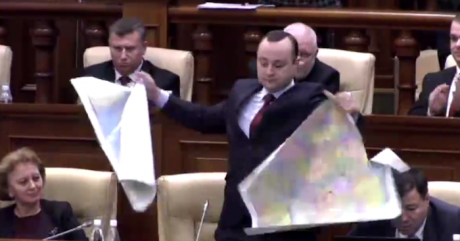
Last autumn, socialist MP Vlad Bătrâncea accused Romania of spreading “unionist propaganda” and tore up a map of Greater Romania in the middle of a parliamentary debate. A group of activists then protested in front of the Socialist Party’s headquarters, and the gesture was condemned by a vast majority of Moldovans. Socialist MP Vlad Bătrâncea tears up a map of Greater Romania in Moldova's parliament. Image still via YouTube.“Don’t play with fire,” began Dodon. “We are the independent state of Moldova. Dear Romanians, we are friends, we are neighbours, we respect you as an independent state, respect us back.”
The subject was raised by the socialists again in an interview for the Russian tabloid publication Komsomolskaya Pravda. Igor Dodon stated that “the Americans have a different scenario, called the 2018 reunification. 2018, to mark a century from the events of 1918.” Dodon accused Romania of making pro-unification overtures, and the USA for supporting them.
A similar position was taken by Renato Usatii, leader of the pro-Russian political movement Our Party, in response to a statement made by Traian Băsescu about reunification. “You are a patriot of Romania, and I am a patriot of Moldova, and that is why reunification will never happen”, said Renato Usatii after the former president of Romania said to Voronin “you will be the president of Greater Romania, and I will be the vice president”.
“You are a patriot of Romania, and I am a patriot of Moldova, and that is why reunification will never happen”
Further controversy was raised when a certain George Simion was expelled from Moldova on 13 May 2015 and declared persona non grata for five years. Simion, a Romanian citizen, was leader of the Unionist Action Platform 2012, advancing the cause of reunification. Though te ban was lifted on September 18, 2015, following the decision of the Chișinău court of appeal (the court ruled that there were no grounds to declare George Simion persona non grata) the Chișinău authorities have nevertheless reinstated the ban, as Simion discovered on 5 February when he tried to visit Moldova.
“I’m being harassed as a citizen of the European Union,” Simion told openDemocracy. He stressed that his organisation pleads for the peaceful unification of Moldova and Romania, and sees all moves against him as politically motivated. Graffiti of King Stephen the Great and an outline map of Greater Romania, Briceni, Moldova, 2014. Photo CC: Julian Nietzsche / wikimedia commons. Some rights reserved.Simion hopes that his case won’t affect bilateral relations between Moldova and Romania, as regular people will suffer the consequences. However, Simion added that he “expects the resignation of those who are guilty. Otherwise, it was just a waste of my time and my health”. He intends to take his case to the European Court of Human Rights.
The voyage home
A study by the Black Sea University Foundation found that in the case of reunification, Romania would have to spend over $90 billion over the next 20-25 years in order to integrate and develop Moldova, including modernising up to Romanian standards.
The same foundation recently organised public debates on a Romanian investment plan named the ”the Marshall Plan for Moldova”.This scheme would guarantee investments made by Romanian and foreign investors in Moldova. Money could flow into Moldova's railway and energy infrastructures. According to academic Petrişor Peiu, Moldova’s economy is almost entirely based on external finances and remittances. As Peiu put it: “Basically, the logic of this state is to send abroad as many citizens as possible. This is wrong.”
"Why be mayor of Chișinău when you can be president of Moldova?"
Article 142 of the Moldova’s constitution allows for the country’s independence to be revised based on a referendum. Until now, only Igor Dodon, leader of the Socialist Party, has stated that he would initiate the procedure to change this article.
Indeed, Socialist MP Bogdan Țîrdea says that in the event of reunification, civil war could break out in Moldova. “It is obvious that unification could irritate some regions of Moldova. Any civil war would have dramatic consequences for the whole eastern European region,” Țîrdea told openDemocracy. Țîrdea’s words may be a political line against reunification, but should not be entirely dismissed. In such a scenario, the fear may not be of a new civil war per se, but of the thawing of the frozen conflict with Transnistria, which benefits from Russian financial and military assistance.
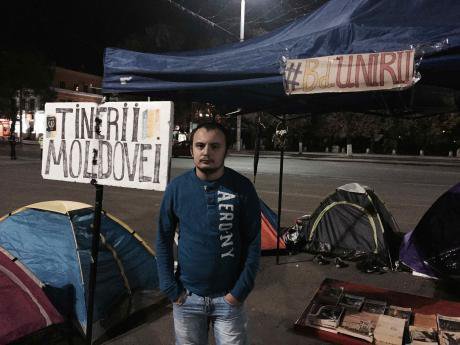
If Moldova is united with Romania, the EU will expand its current borders. In this case, Russia might have a new argument to legitimise the annexation of Crimea in 2014. Unsurprisingly, many observers fear Russia's possible reactions to such a move. For Vitaly Prisekar, an activist with the Youth of Moldova unionist organisation, reunification isn't about historic justice, but simply makes economic sense. Photo (c): Maria Levcenco, Chișinău, 2015.“The second Romanian state [ed. Moldova] has a chance to leave Russian influence behind by reuniting with Romania.,”, says Vitalia Pavlicenco, leader of the National Liberal Party. The party’s platform includes a referendum on unification with Romania, and notes that Moldova has poor prospects of EU accession alone.
“Momentum is on our side now Russia has weakened,” continues Pavlicenco. “Even the Transnistrian region, which is still fully under control of Russia but without finances or perspective, could accept the idea. It's all about time. They could take a step back now, and take revenge later.”
Anatol Șalaru, defence minister of Moldova and vice-president of the National Liberal Party, echoes these sentiments. “It is absurd to believe that Russia will attack NATO just because Romania is uniting with Moldova,” Șalaru said in an interview this month with deschide.md. “Even Russians recognise that it is Romanian land. If Russia wants to attack Romania, and therefore NATO, they will do it with or without reunification.”
In any case, the power to change borders is only up the people of both Moldova and Romania — including more than 750,000 who have dual citizenship. Yet reunification remains a pipe dream. After all, as Charles King wrote: “why be mayor of Chișinău when you can be president of Moldova?”
Read more
Get our weekly email


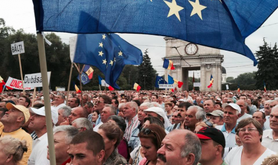
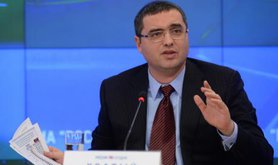
Comments
We encourage anyone to comment, please consult the oD commenting guidelines if you have any questions.